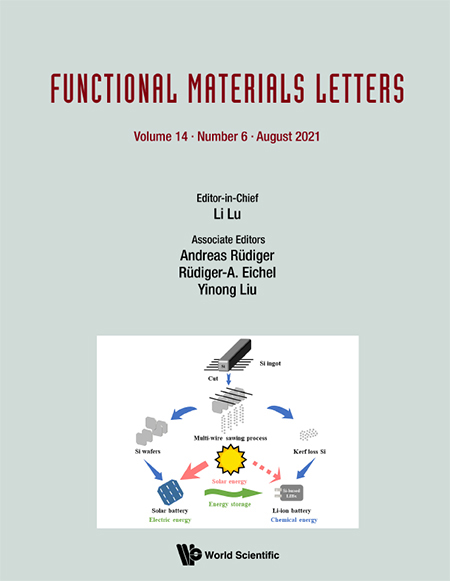Interface construction for charge transportation of ZnO/graphene multilayer films
Abstract
In order to clarify the effect of interface construction on the charge transportation, the interfaces between zinc oxide (ZnO) and graphene layers were designed into the following types: the smooth interface by direct deposition ZnO layer onto the surface of fresh graphene/glass substrate; the nanoscale rough interface by Ar bombardment etching the surface of graphene/glass substrate before deposition of a ZnO layer, and rough ZnO/Ag/graphene interface by deposition Ag first and then ZnO layers on the rough graphene/glass substrate. The results showed that, compared to the morphology of the ZnO/graphene film with smooth surface, the particle sizes of the film with rough interface became fine and their shapes changed from sharp to round. The carriers’ mobility increased from 0.3 cm2 ⋅ V ⋅ s to 0.6 cm2 ⋅ V ⋅ s due to the enhancement of the nanocontact at the rough interface between ZnO and graphene layers. In order to improve the electrical properties of ZnO/graphene multilayer film, a 10 nm Ag layer was inserted into the rough graphene/glass and ZnO layer to construct the rough metal interface. The carrier concentration was enhanced from 10 cm of ZnO/graphene to 10 cm ZnO/Ag/graphene films, although the carrier mobility reduced slightly from ZnO/graphene 0.6 to ZnO/Ag/graphene 0.2 cm2 ⋅ V ⋅ s. The sheet resistance and resistivity of the ZnO/Ag/graphene multilayer film decreased dramatically by inserting the conductive Ag layer, which took the roles of both the provider of charge carriers from Ag layer and bridges of the carriers from graphene layer.
References
- 1. , Chin. Phys. Lett. 30, 017302 (2013). Crossref, ISI, Google Scholar
- 2. , Nature 427, 523 (2004). Crossref, ISI, Google Scholar
- 3. , Chin. Phys. Lett. 29, 107402 (2012). Crossref, ISI, Google Scholar
- 4. , Chin. Phys. Lett. 26, 107302 (2009). Crossref, Google Scholar
- 5. , Adv. Mater. 23, 1475 (2011). Crossref, Google Scholar
- 6. , Adv. Mater. 21, 4087 (2010). Crossref, ISI, Google Scholar
- 7. , Appl. Phys. Lett. 84, 3654 (2004). Crossref, ISI, Google Scholar
- 8. ,
Properties and applications of ZnO , in Zinc Oxide Bulk, Thin Films Nanostructures, Elsevier Science, Netherlands (2006). Crossref, Google Scholar - 9. , Nat. Mater. 6, 183 (2007). Crossref, ISI, Google Scholar
- 10. , Nat. Nanotechnol. 5, 574 (2011). Crossref, ISI, Google Scholar
- 11. , Science 321, 385 (2008). Crossref, ISI, Google Scholar
- 12. , J. Phys. Chem. B 108, 19912 (2004). Crossref, ISI, Google Scholar
- 13. , Science 320, 1308 (2008). Crossref, ISI, Google Scholar
- 14. , Vacuum 128, 34 (2016). Crossref, ISI, Google Scholar
- 15. , Nat. Mater. 6, 770 (2007). Crossref, ISI, Google Scholar
- 16. , J. Phys.: Condens. Matter 27, 223201 (2015). Crossref, ISI, Google Scholar
- 17. , Meas. Sci. Technol. 27, 074006 (2016). Crossref, ISI, Google Scholar
- 18. , Appl. Phys. Lett. 90, 220 (2007). Google Scholar
- 19. , Thin Solid Films. 326, 67 (1998). Crossref, ISI, Google Scholar
- 20. , Nanosci. Nanotechnol. Lett. 7, 743 (2015). Crossref, ISI, Google Scholar
- 21. , J. Appl. Phys. 80, 440 (1996). Crossref, ISI, Google Scholar
- 22. , Phys. Rev. Lett. 97, 187401 (2006). Crossref, ISI, Google Scholar
- 23. , J. Cryst. Growth 130, 269 (1993). Crossref, ISI, Google Scholar
- 24. , Surf. Coat. Technol. 306, 119 (2016). Crossref, ISI, Google Scholar
- 25. , Nanosci. Nanotechnol. Lett. 10, 329 (2018). Crossref, ISI, Google Scholar
- 26. , IEEE Trans. Electron. Devices 62, 4139 (2015). Crossref, ISI, Google Scholar
- 27. , Adv. Funct. Mater. 27, 1606641 (2017). Crossref, ISI, Google Scholar
- 28. , Phys. Rev. B 69, 165409 (2004). Crossref, ISI, Google Scholar
- 29. , Thin Solid Films 418, 112 (2002). Crossref, ISI, Google Scholar
- 30. , Phys. Rev. Lett. 101, 026801 (2008). Crossref, ISI, Google Scholar
- 31. , Acc. Chem. Res. 46, 2329 (2013). Crossref, ISI, Google Scholar
| Remember to check out the Most Cited Articles! |
|---|
|
Check out New Titles in Materials Science and Nanotechnology |


